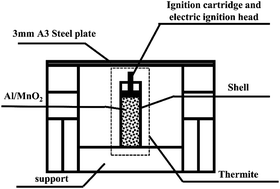The characteristics of combustion reactions involving thermite under different shell materials
Abstract
To study the influence of tubular shell materials on the combustion of thermite, numerical simulations and experimental comparisons of the combustion efficiencies of thermite with PVC and stainless-steel shell materials were carried out. The thermal conductivity coefficient and heat radiation correlation coefficient of a shell material directly affect heat transfer during a heat-transfer process, that is, the lower the thermal conductivity and the higher the heat radiation reflectance coefficient, the lower the heat flux through the material and the less heat is lost. The experimental results show that compared with the stainless-steel tube material, the temperature distribution of thermite is more concentrated and the effect of melting through a steel target plate is more apparent when PVC is used as the shell material. The simulation results show that thermite in the PVC shell can produce a higher temperature, reaching 2200 °C at the loading port and 1700 °C on the steel target plate, which is maintained for 0.9 s. However, the corresponding maximum temperatures for the stainless-steel shell are only 2000 °C and 1500 °C, not yet reaching the melting point of the steel plate. The simulation results are consistent with the experimental phenomena. This work is of great significance for improving the design of thermite shells, enhancing performance, and guiding future combustion process research.



 Please wait while we load your content...
Please wait while we load your content...